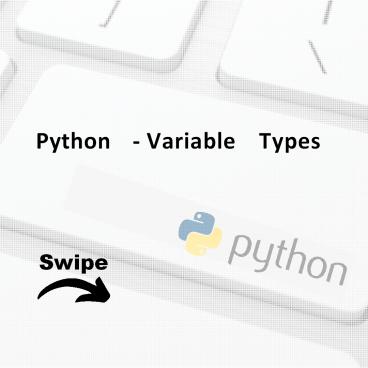Python variables types - PowerPoint PPT Presentation
Title:
Python variables types
Description:
This presentation educates you about the types o python variables, Assigning Values to Variables, Multiple Assignment, Standard Data Types, Data Type Conversion and Function & Description. For more topics stay tuned with Learnbay. – PowerPoint PPT presentation
Number of Views:374
Title: Python variables types
1
Python - Variable Types
Swipe
2
Python - Variable Types
Variables are nothing but reserved memory
locations to store values. This means that when
you create a variable you reserve some space in
memory. Based on the data type of a variable,
the interpreter allocates memory and decides
what can be stored in the reserved
memory. Therefore, by assigning different data
types to variables, you can store integers,
decimals or characters in these variables.
3
Assigning Values to Variables
Python variables do not need explicit declaration
to reserve memory space. The declaration
happens automatically when you assign a value to
a variable. The equal sign () is used to assign
values to variables.
4
The operand to the left of the operator is the
name of the variable and the operand to the right
of the operator is the value stored in the
variable. For example - !/usr/bin/python
counter 100 miles 1000.0
An integer assignment A floating point A
stringprint counter
name "John" print miles print name
Here, 100, 1000.0 and "John" are the values
assigned to counter, miles, and name variables,
respectively. This produces the following result
- 100 1000.0 John
5
Multiple Assignment
Python allows you to assign a single value to
several variables simultaneously. For example -
a b c 1 Here, an integer object is
created with the value 1, and all three
variables are assigned to the same memory
location. You can also assign multiple objects
to multiple variables. For example - a,b,c
1,2,"john" Here, two integer objects with values
1 and 2 are assigned to variables a and b
respectively, and one string object with the
value "john" is assigned to the variable c
6
Standard Data Types
The data stored in memory can be of many
types. For example, a person's age is stored as
a numeric value and his or her address is stored
as alphanumeric characters. Python has various
standard data types that are used to define the
operations possible on them and the storage
method for each of them. Python has five standard
data types - Numbers String List
Tuple Dictionary
7
Data Type Conversion
- Sometimes, you may need to perform conversions
between the built-in types. - To convert between types, you simply use the type
name as a function. - There are several built-in functions to perform
conversion from one data type to another. - These functions return a new object representing
the converted value.
8
Function Description
int(x ,base) Converts x to an integer. base
specifies the base if x is a string. long(x
,base ) Converts x to a long integer. base
specifies the base if x is a string. float(x) Con
verts x to a floating-point number. complex(real
,imag) Creates a complex number.
str(x) Converts object x to a string
representation. repr(x) Converts object x to an
expression string. eval(str) Evaluates a string
and returns an object. oct(x) Converts an
integer to an octal string.
9
tuple(s) Converts s to a tuple. list(s) Converts
s to a list. set(s) Converts s to a set.
dict(d) Creates a dictionary. d must be a
sequence of (key,value) tuples. frozenset(s) Conv
erts s to a frozen set. chr(x) Converts an
integer to a character. unichr(x) Converts an
integer to a Unicode character. ord(x) Converts
a single character to its integer value.
hex(x) Converts an integer to a hexadecimal
string.
10
Topics for next Post
Python Standard Data Types Python
Operations Stay Tuned with































